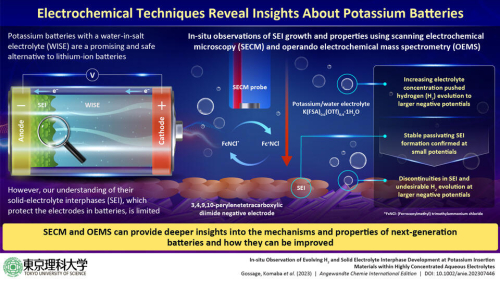Energy & Critical Metals
TUS researchers offer insights into solid-electrolyte interphases in next-gen aqueous potassium-ion batteries
Lithium-ion batteries (LIBs) have become immensely popular as the go-to power source for a wide variety of electronic devices and vehicles over the past…

Lithium-ion batteries (LIBs) have become immensely popular as the go-to power source for a wide variety of electronic devices and vehicles over the past two decades. Although it is hard to overstate the transformative effects that LIBs have had on modern societies, this technology has a fair share of disadvantages that cannot be ignored any further. These include the limited availability of lithium as well as safety and environmental concerns. These drawbacks have motivated scientists around the world to look for alternative battery technologies, such as aqueous batteries.
Potassium-ion batteries (KIBs) represent a possible aqueous battery alternative to lithium-ion batteries (LIBs). KIBs are made from abundantly available materials and are much safer than LIBs. Moreover, KIBs can utilize a water-in-salt electrolyte (WISE), which makes them more stable thermally and chemically.
However, the prevention of hydrogen evolution at the negative electrode for its stabilization is a major challenge in high-voltage aqueous batteries. While solid-electrolyte interphases (SEI) that form between these electrodes and the electrolyte solution help stabilize the electrodes in LIBs (by preventing electrolyte decomposition and self-discharge of the batteries), they have been scarcely researched in the context of KIBs.
To address this major knowledge gap, a research team from Tokyo University of Science (TUS), Japan, led by TUS Professor Shinichi Komaba recently conducted a study to gain insights into SEI formation and their properties in WISE-based KIBs. Their findings are published in an open-access paper in the journal Angewandte Chemie International Edition.
The researchers mainly employed two advanced analytical techniques—scanning electrochemical microscopy (SECM) and operando electrochemical mass spectrometry (OEMS)—to observe how SEI forms and reacts in real time during the operation of a KIB with a 3,4,9,10-perylenetetracarboxylic diimide negative electrode and 55 mol/kg K(FSA)0.6(OTf)0.4∙1H2O, a WISE developed by the team in a previous study.
The experiments revealed that SEI forms a passivating layer in WISE akin to that seen in LIBs, with slow apparent electron transfer rates, helping suppress hydrogen evolution. This can ensure stable performance and higher durability of KIBs. However, the researchers observed that the coverage of the SEI layer was incomplete at higher operating voltages, leading to hydrogen evolution.
Taken together, the results reveal the need to explore potential avenues to enhance SEI formation in future aqueous batteries.
While our results reveal interesting details on the properties and stability of SEI found in one particular WISE, we should also focus on reinforcing the SEI network to achieve improved functionality. SEI could perhaps be improved by the development of other electrolytes that produce unique SEIs, but also through the incorporation of electrolyte additives or electrode surface pretreatment.
—Prof Komba
This study also highlights the power of SECM and OEMS for gaining a solid understanding of electrode–electrolyte interactions in next-generation batteries.
These techniques provide a powerful means for tracking the development, coverage, ion transfer, and stability of SEI and can easily be adapted for a variety of electrolytes and electrodes. We hope that this work encourages other researchers to further explore SECM and OEMS as advanced characterization methods that can be incorporated with traditional battery measurements to gain deeper insights.
—Prof Komba
Resources
-
Gossage, Z. T., Ito, N., Hosaka, T., Tatara, R., Komaba, S. (2023)“In-situ Observation of Evolving H2 and Solid Electrolyte Interphase Development at Potassium Insertion Materials within Highly Concentrated Aqueous Electrolytes”, Angew. Chem. Int. Ed. doi: 10.1002/anie.202307446

Uranium Exploration Company Announces Additional Staking in the Athabasca Basin
Source: Streetwise Reports 12/22/2023
Skyharbour Resources Ltd. announced an update from its Canada-based Falcon Project along with additional…
Tesla Launches New Mega Factory Project In Shanghai, Designed To Manufacture 10,000 Megapacks Per Year
Tesla Launches New Mega Factory Project In Shanghai, Designed To Manufacture 10,000 Megapacks Per Year
Tesla has launched a new mega factory…
Giving thanks and taking stock after “a remarkable year”
An end-of-year thank you to our readers, industry colleagues and advertisers before Electric Autonomy breaks from publishing until Jan. 2
The post Giving…











